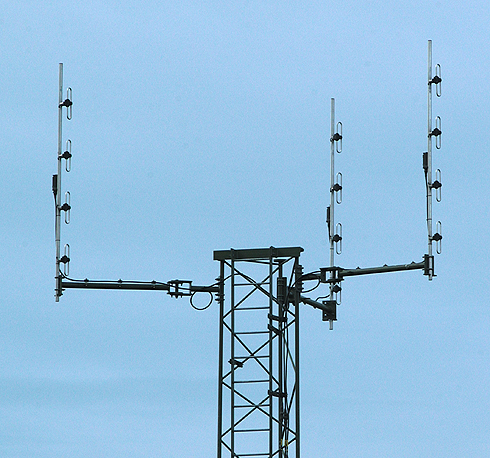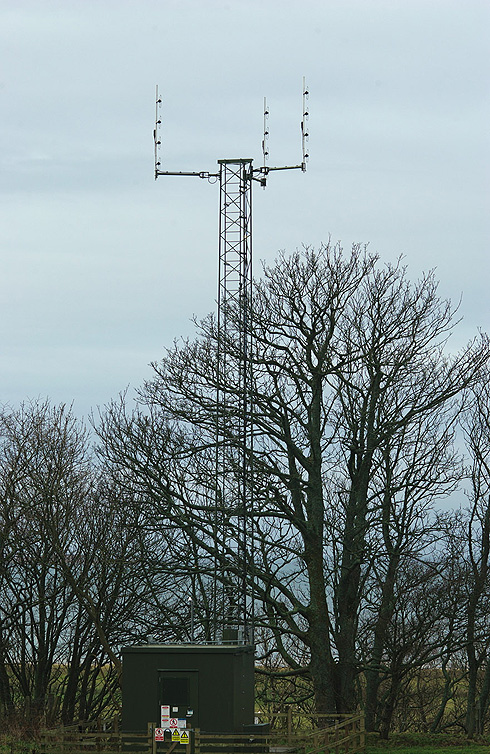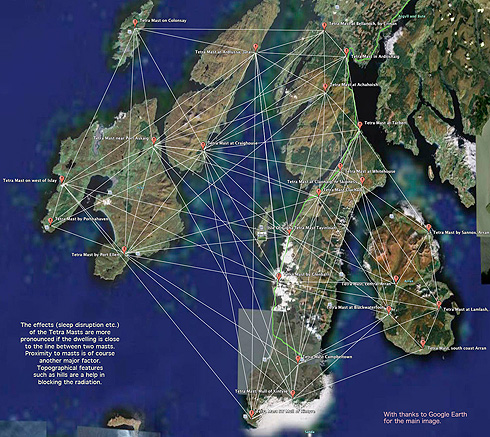A Brief Guide to TETRA masts (in the UK) and their impact

In the late 1990’s the UK government under Tony Blair awarded a contract to the telecomms giant O2, for them to construct a nationwide communications network for the police and emergency services. O2 created a subsidiary company called Airwave to carry out this contract. By 2008 the government had spent in excess of £14,000,000,000 (£14 billion) with Airwave on this contract, with many thousands of masts dedicated to this network being erected across all parts of the UK except Northern Ireland and the Channel Islands.
The technology that Airwave initially chose to install combined microwave frequencies with a secondary modulation frequency. However the first generation of Tetra (which stands for “Terrestrial Trunk Radio”)that Airwave put up interfered with some TV reception. This caused sufficient protest that Airwave quickly switched to another form of the dual-frequency technology. It is this “second-generation” Tetra network that has been set up across the UK since 1999. As of November 2011 when this article is being written, this is still the technology that Airwave have been erecting and installing, and it is this current “second generation” Tetra that is our subject here.
Microwaves Unfortunate Technical Limitation
Microwaves have been used by the military in various countries since the late 1950’s for communication networks. It is only relatively recently that the civilian use of microwaves for this purpose has exploded across the globe in the form of our mobile phone / cellular phone networks. But as any mobile phone user will know, these phones do not work well if you are inside a building or in a tunnel. Microwaves by their very nature do not penetrate big thick solid walls.
And that is why some very clever people worked out how to get microwaves to overcome that limitation of their nature. In the current form of the UK’s Tetra network, the microwaves are combined with a very low frequency carrier wave. They do this by “modulating the power amplitude”. This is the equivalent of listening to a radio station, and turning the volume up and down as you listen. The 2nd generation Tetra masts combine microwave frequencies with a modulation of the power amplitude at 17.65 hz (1 hertz = 1 hz = 1 cycle per second). This is indeed a clever way to enable microwaves to penetrate big thick solid walls.
Unfortunately it is also a very good way to prevent much of the UK population from getting deep and restful sleep at night. Why? Because when we go to sleep, our brainwave pattern has to get down to 3 hz or less (3 cycles per second or less); really deep sleep may be as low as 1 hz. Our waking state brainwave pattern is roughly between 12 and 25 hz, the “beta” rhythm.
Now just what happens to the citizens of a country that decides to install masts all across the country, in or near every village and city, broadcasting a high-power and high-amplitude wave pattern which is in the middle of our waking-state brainwave rhythm? The simple answer is that a large portion of that population will suffer badly from inadequate and disturbed sleep patterns, at the very least. But there are many other symptoms that arise. As Jay Griffiths, writing in The Ecologist reported in October 2004:
When a Tetra mast was switched on in Dursley in Gloucestershire people there complained of migraines, sleeplessness, nosebleeds and being ‘shocked awake’ up to 15 times a night. At a school in Littlehampton, Sussex, 11 children had to be sent home on the day that a nearby Tetra mast went live. The children suffered dizziness and, like the residents of Dursley, severe headaches and nosebleeds. (Interestingly, the local community did not know the mast had been switched on, so the children’s reactions could not have been psychosomatic.) At Drumcarrow Hill in Fife a Tetra transmitter has been in operation since the late 1990s. Only about 200 people live around the mast, but there have been at least seven recent cases of cancer and five cases of motor neurone disease (MND) diagnosed in the area over the past five years. (Normally, no more than two people to every 100,000 is diagnosed with MND per year.)
MND is a particularly nasty and fatal degenerative disease. Last year Dr Neil Cherry, former associate professor of environmental health at Lincoln University, died from it, convinced he had contracted MND as a consequence of his long exposure to low-frequency radiation, the potential health hazards of which he researched. Cherry’s work suggests that low-level radiation, and Tetra, could also cause heart and blood problems, interference with bone marrow and tumours.
In October 2003 Airwave erected a Tetra mast a quarter mile from the centre of the village of Tayinloan, on the Kintyre peninsula. Tayinloan (pop. 550) is where the ferry for our island departs from. The mast went live in November 2003, and by the middle of Decemember 2003 there were 5 deaths in the village. These included a couple in their late 40’s, with the wife dying of a brain haemorahage, and the husband of a heart attack. There are many other such clusters in villages across the UK following Tetra masts being erected nearby.
However, the focus of this website’s article is not on these other health concerns, serious as they are. Most websites dealing with the subject have been far too technical for most of us to follow the key points as they affect people still living in the UK.
Simply on the face of it, there would be appear to be grave concerns about subjecting the entire population of a country to such radiation, and that could be described on two main points.

First of all, it is accepted amongst the medical & scientific community that some 5% of the population are what they describe as “electro-magnetically hypersensitive”. For one person in every 20, being subjected to any form of powerful electromagnetic radiation can be very difficult. For example, an English school found that one of their highly regarded History teachers would become immediately ill with headaches etc. as soon as the wireless networking equipment was turned on in his classroom. This case led to the National Union of Teachers raising concerns with the government about the safety of wifi technology.
Not everyone is so badly affected by the technology of course. But this 5% of the general population may be best regarded as akin the canaries that miners used to take down into the mines. The canaries were more sensitive to toxic gases then the men, so if the miners saw that a canary had died, they would quickly get out of the mine, as it was a signal that dangerous levels of gases were building up. We are living in a time when outrageous levels of electromagnetic “pollution” or “electrosmog” are wreaking havoc with the health of the most electro-sensitive people in our midst. We should be giving their concerns and responses to the technology far more attention.
Their responses deserve greater attention for two reasons. First of all, the 5% “electro-magnetically hypersensitive” portion of the population are not actually a different race of homo sapiens: they and we are one people, and what causes illness very quickly in this section of the population, is also likely to cause illness more slowly in the rest of the population.
The second reason we should heed their concerns has to do with a fundamental aspect of the impact of this radiation on our bodies. The key statement to understand is this: that the effects of microwave radiation on tissue are cumulative. That is to say, getting a low-level dose of microwaves constantly over many years, is the equivalent (as far as your body is concerned) of getting that same dose in one short high-level burst. Governments and scientists have known this fact for over 60 years, ever since the first microwave masts went up for the military communications. The engineers performing maintencance on those early masts had a very strong tendency to go blind within the first year of doing their work on those masts. In effect their eyeballs had been slowly cooked by their exposure to the microwaves of the masts they were maintaining. It was these early experiences of the military engineers with this technology that has led to our understanding today that the effects of microwaves on tissue accumulate.
The second main point of grave concern about subjecting the entire population of a country to the Tetra radiation is very simple. If we broadcast a high-amplitude wave pattern across the entire country which has its frequency set right in the middle of our waking-state brainwave pattern, then it stands to reason that some portion of the population are going to have their sleep patterns adversely effected by such exposure. Bear in mind that the Tetra masts do not operate only by day, but are active 24 hours a day throughout the year. It is reasonable to expect that at the very least the 5% who are most sensitive to electro-magnetic radiation are going to feel the impact of this fairly severely; and the evidence points to far more than 5% of the UK population being seriously adversely effected by the Tetra network as implemented by Airwave.
We run a traditional mail order business here, and in this way we not only hear from people all across the UK throughout the year, but we also hear from therapists, who report that the great majority of their clients are constantly exhausted.
By using the govenernment-run website
http://www.sitefinder.ofcom.org.uk/
you can enter your post code, and find out (with some effort and difficulty) where your nearby Tetra masts are located. I do this search on a regular basis for people who call. I am usually able to describe their sleep pattern to them, on the basis of how close they are to a Tetra mast. The typical Tetra-induced disturbed sleep pattern is as follows: first they will sleep for about 90 minutes, then wake up. After a short while they get back to sleep again, for roughly another hour, and then wake up. Then after a further interval they get maybe 30 miore minutes of sleep, wake up exhausted but unable to get any further sleep.
This pattern becomes more pronounced if the individual is closer to a mast, or is more susceptible to the radiation.
We run our premises as a B&B during half the year. In 2007 we had a guest who works as a nurse at a hospital in Oxfordshire. As we talked, she described how almost everyone coming to the hospital these days was suffering from anxiety and panic attacks. She also told me that the doctors fill in a form by hand for every patient when they arrive, the information of which which later gets entered onto the computer system. However, she explained that there is an acronym “TATT” which she sees written in the margins of almost every form, and this acronym never gets put onto the computer records. What does TATT stand for? Tired All The Time.
A customer of ours called one day, wanting a few of our essences to give her more energy. I asked what her sleep pattern was like, and she said that when she was back in Florida visiting her family, she slept great and had plenty of energy. But as soon as she was back home in Kent, she was constantly exhausted and yet could not get a good night’s sleep. She had a Tetra mast one mile down the road from her.
What is a Safe Distance from a Tetra Mast?
This of course raises the obvious question, and unfortunately there is no happy answer. Even 3 miles is certainly not a sufficient distance to allow undisturbed sleep. And on the UK mainland, the odds are that 90% of the population are living within 2 miles of at least 2 or 3 Tetra Masts.
The situation is exacerbated by the way in which the impact of the Tetra masts is increased if you live near the line which could be drawn between two masts. Draw lines on a map of all the Tetra masts in your area, and it ends up looking like a spider’s web, and one which is very difficult to escape from.
Useful equipment (such as electro-smog meters, as well as protective bed canopies) may be found at this website:
http://www.emfields.org/

What can you do about it?
The most important thing is to take the first step and become informed. Ignorance in this instance is definitely not bliss!
Secondly, write to your local MP about the matter. They need to hear our concerns.
Take the occasional holiday break outside of the UK. France is far far better regarding microwave pollution. The UK authorities are the worst in Europe for the risks they allow us to be exposed to, whether we want it or not.
Examine the options presented by the people at the above website. They know what they are talking about, and they offer very good products, as well as advice.
Beyond that, there is little more I can say on the matter in this article. But it is now more than 12 years since the 2nd generation Tetra masts first started going up across the UK, and there is sadly no prospect of them being removed in the near future.
A good friend of ours was attending a course in the south of England a few years ago, and the participants had to pair off with one another. The woman that my friend paired up with turned out to be an engineer who worked at O2. Her work was specifically in the research division working on the Tetra mast network. She said to my friend, “Oh yes, with the first generation of the Tetra masts, there was interference with TV reception, but we addressed that with the second-generation Tetra. And with the 3rd generation Tetra masts, we’ll address the biological effects.”
To date there is no sign at all of the 3rd generation technology (whatever that may be!) being rolled out. Given the economic times we are in now, there can be little prospect of O2 / Airwave being paid further billions of Pounds Sterling to introduce the next generation, and so it looks like we are stuck with the Tetra masts as they currently stand.
For much more information please visit this website:
http://www.tetrawatch.net
ESSENCE REPERTOIRE


2015 Seminars
Seminar Summary
2015 Seminars
Tel: 01583 505 158
Mob: 07584 729 204
We are open to receive telephone orders Monday through Friday
from 10 am till 5 pm except on Bank Holidays.
IFER
Tarbert Farm
Isle of Gigha
Argyll
PA41 7AA


